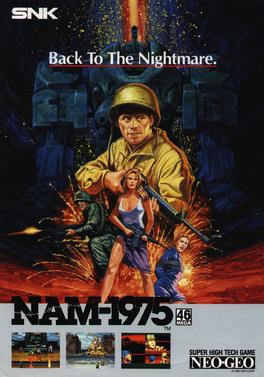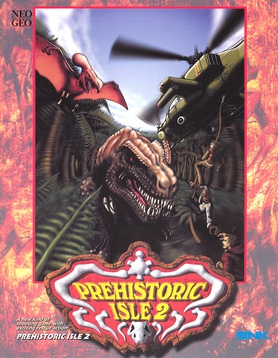
Waku Waku 7 is a 2D fighting game developed and published by Sunsoft initially as an arcade game for the Neo Geo MVS arcade system in 1996 worldwide.

World Heroes Perfect is a 1995 fighting arcade game developed and published by ADK with the assistance of SNK. It was originally released for the Neo Geo MVS arcade cabinet on May 25, 1995. It is the fourth and final title of the World Heroes series.

Money Puzzle Exchanger is a puzzle game created on January 17, 1997 by Japanese video game developer Face for the Neo Geo MVS arcade system. Athena Co. Ltd. ported it to the Game Boy on August 29, 1997, and the PlayStation on November 5, 1998. The Japanese PlayStation version was made available by MonkeyPaw Games on the PlayStation Network's import store on November 16, 2010. It was later re-released as part of the Arcade Archives Neo Geo series for PlayStation 4, Xbox One and Nintendo Switch on June 28, 2018.

NAM-1975 is a war shooting gallery arcade video game developed and originally published by SNK on April 26, 1990. It was one of the launch titles for both the Neo Geo MVS (arcade) and Neo Geo AES (home) platforms, in addition to being the only title in the system that does not feature the Neo Geo boot screen in its attract mode, as well as one of the pack-in games for the AES.

Aero Fighters 2 is a vertical-scrolling shoot 'em up arcade game released in 1994 by Video System. It is developed by SNK and released in Japan, North America and Europe. It is the second part of the Aero Fighters series followed by the third part Aero Fighters 3 and a spin-off Aero Fighters Assault. It was initially released as a cabinet token base game.

Ninja Master's: Haō Ninpō Chō,, is a ninja-themed 2D fighting game produced by ADK and originally released in 1996 for the Neo Geo arcade and home platform. Ninja Master's was the sixth and final fighting game produced by ADK, following the four games in the World Heroes series and Aggressors of Dark Kombat. It was later featured in the 2008 compilation ADK Damashii for the PlayStation 2. Ninja Master's was also re-released on the Neo-Geo X handheld system in 2012, and for the Virtual Console in 2013. In 2019 it was released as part of Arcade Archives developed by Japanese company Hamster. As of 2021, Ninja Master's was released worldwide on Nintendo Switch and Xbox One. The PS4 version remains exclusive to Asia but includes both Japanese and English releases.

Burning Fight is a beat 'em up arcade game released by SNK in 1991 for the Neo Geo MVS system. Introduced to capture a share in the then-popular beat 'em ups market, it was meant to compete with Technōs' Double Dragon, the leader of the genre at the time. Three years after its release in the arcades and on the Neo Geo AES, it was released on Neo Geo CD as the only other home version.

Neo Bomberman is an action-maze arcade video game developed by Produce! and published by Hudson Soft for the Neo Geo MVS on May 1, 1997. It is one of two games in the Bomberman franchise that was released for the Neo Geo platform, the first being Panic Bomber, and the only one to retain its traditional top-down gameplay. It was released for the Neo Geo MVS (arcade) and has not received a home console release to date. It was the last original Bomberman title to be released for arcades until Konami's Bombergirl in 2018.

Zed Blade is a horizontally scrolling shooter arcade video game developed by NMK and originally published by SNK on September 13, 1994. It is the only game created by NMK for the Neo Geo arcade platform. In a science fiction setting, players choose one of three characters to attempt to overthrow an army of enemies led by the on-board supercomputer at the automated Yggdrasil space station and seize full control of it once again.
Arcade Archives is a series of emulated arcade games from the late 1970s, 1980s, 1990s, and early 2000s for PlayStation 4, Xbox One, Microsoft Windows, and Nintendo Switch, published by Hamster Corporation. A sub-series called ACA Neo Geo is focused on re-releasing Neo Geo titles in their original arcade format, unlike many services with attempts to emulate the console versions.

Paon DP Co., Ltd. (株式会社パオン・ディーピー) is a Japanese video game developer. The company was founded in August 2004 as DP Inc. and merged with Paon Corporation, Ltd. in March 2015 to form Paon DP.

Puzzled is a falling-block puzzle video game developed and published by SNK that was released for Neo Geo arcade hardware in 1990, the Neo Geo home console in 1991, and the Neo Geo CD in 1994. The game was ported to mobile phones in 2005, then was re-published by D4 Enterprise on the Wii Virtual Console in June 2011, and it is also one of the twenty games that came pre-loaded on the Neo Geo X console released in 2012. It was also ported in August 2017 to Nintendo Switch, Xbox One, and PlayStation 4 as part of Hamster Corporation's ACA Neo Geo series.

Sun Shine is an unreleased 1990 tile-matching puzzle arcade video game that was in development by Alpha Denshi and planned to be published by SNK for both the Neo Geo MVS (arcade) and Neo Geo AES (home) platforms. It is the first puzzle game to be developed for both systems and the smallest Neo Geo game in terms of memory data.

Mystic Wand is an unreleased 1991 puzzle-platform game that was in development and planned to be published by Alpha Denshi for both the Neo Geo MVS (arcade) and Neo Geo AES (home) platforms.

Ghostlop is an unreleased 1996 puzzle arcade video game that was in development by Data East and planned to be published by SNK for the Neo Geo MVS (arcade), Neo Geo AES (home) and Neo Geo CD. In the game, players assume the role of ghosthunters Bruce and McCoy from the Data Ghost agency to evict mischievous ghosts across multiple locations. Its gameplay mainly consists of puzzle mixed with Breakout-style action elements using a main two-button configuration.

Pochi and Nyaa is a puzzle video game developed by Aiky and released by Taito towards the end of 2003 for the Neo Geo. It was one of the last games developed for the platform, as well as the final Neo Geo MVS title developed by a third-party company. In 2004, it was ported to the PlayStation 2 by Bandai, featuring several improvements and new characters.

Power Spikes II is a volleyball arcade video game developed by Video System and originally published by Taito on October 19, 1994. A follow-up to Hyper V-Ball on Super Nintendo Entertainment System, it was first launched for Neo Geo MVS (arcade) and later ported to Neo Geo CD. It is the final installment in the Super Volleyball series. It is also the only volleyball game released on the Neo Geo.

Over Top is a racing arcade video game developed by ADK and originally published by SNK on April 26, 1996. It is the spiritual successor to Thrash Rally, which was released earlier in 1991 on Neo Geo platforms.

Prehistoric Isle 2 is a 1999 scrolling shooter arcade video game co-developed by Saurus and Yumekobo and published by SNK. It is the sequel to the original Prehistoric Isle, which was developed and released earlier in 1989 by SNK. In the game, players take control of helicopters to shoot at dinosaurs while rescuing people. Although first launched in arcades, the title has since been re-released through download services for various consoles. It received mixed reception since its initial arcade release and garnered less success than its predecessor.

Magical Drop II is a 1996 puzzle video game developed and published by Data East for the Neo Geo arcade and home platforms. It was later ported to Neo Geo CD, Super Famicom, and Sega Saturn. It is the second entry in the Magical Drop series. In the game, the player takes control of one of several characters, battling against computer-controlled opponents before facing the villainous Empress in a final encounter. Gameplay is similar to its predecessor Magical Drop (1995) albeit with improvements; the objective is to clear the screen of constantly advancing colored 'drops' via a character placed at the bottom of the playfield, which can grab drops and make them disappear by putting them as a column of three or more drops of the same color. Two players can also participate in a competitive versus mode.




















